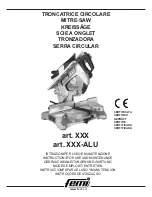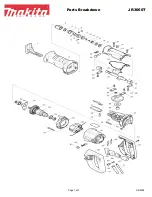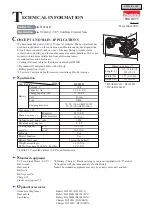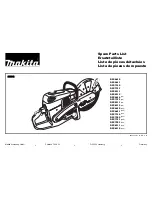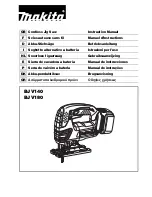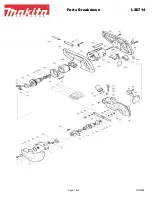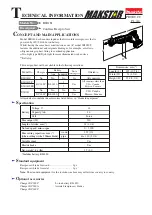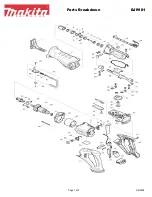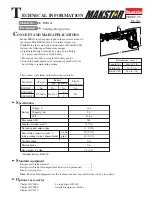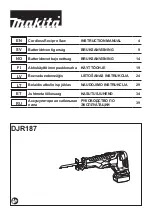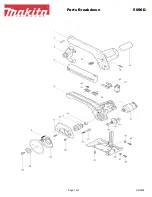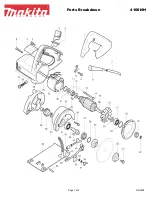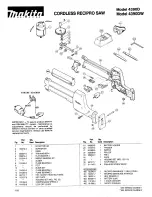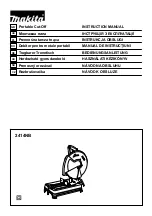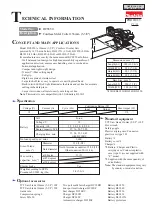
4 ENGLISH
14.
Check Damaged Parts
- Before further use of the
appliance, a guard or other part that is damaged
should be carefully checked to determine that it will
operate properly and perform its intended function.
Check for alignment of moving parts, binding of
moving parts, breakage of parts, mounting, and any
other condition that may affect its operation. A guard
or other part that is damaged should be properly
repaired or replaced by an authorized service cen
-
ter unless indicated elsewhere in this manual.
15.
Keep all parts of the body away from the saw
chain. Do not remove cut material or hold
material to be cut when blades are moving.
Make sure the switch is off when clearing
jammed material.
Saw chain continues to move
after the switch is turned off. A moment of inatten
-
tion while operating the extended-reach pruner
may result in serious personal injury.
16.
Carry the pole pruner by the handle with the saw
chain stopped. When transporting or storing
the pole pruner, always fit the saw chain device
cover.
Proper handling of the pole pruner will reduce
possible personal injury from the saw chain.
17.
Hold the pole pruner by insulated gripping sur-
faces only, because the saw chain may contact
hidden wiring.
A saw chain contacting a ″live″ wire
may make exposed metal parts of the pole pruner
″live″ and could give the operator an electric shock.
18.
Do not use the pole pruner in bad weather
conditions, especially when there is a risk of
lightning.
This decreases the risk of being struck
by lightning.
19.
To reduce the risk of electrocution, never use
near any electrical power lines.
Contact with or
use near power lines may cause serious injury or
electric shock resulting in death.
20.
Always use two hands when operating the pole
pruner. Hold the pole pruner with both hands
to avoid loss of control.
21.
Always use head protection when operating
the pole pruner overhead.
Falling debris can
result in serious personal injury.
22.
When replacing batteries, all batteries should
be replaced at the same time in case the tool
employs more than one battery.
Mixing fresh and
discharged batteries could increase internal cell
pressure and rupture the discharge battery(ies).
23.
Remove or disconnect battery before ser-
vicing, cleaning or removing material from
the appliance.
Such preventive safety mea-
sures reduce the risk of starting the appliance
accidentally.
24.
Use only the battery(ies) listed in
“SPECIFICATIONS”.
Use of any other batteries
may create a risk of fire.
25.
Exercise care in handling batteries in order not
to short the battery with conducting materials
such as rings, bracelets, and keys.
The battery
or conductor may overheat and cause burns.
26.
A battery operated appliance with integral
batteries or a separate battery pack must be
recharged only with the specified charger for
the battery.
A charger that may be suitable for one
type of battery may create a risk of fire when used
with another battery.
27.
Remove adjusting keys or wrenches before
turning the appliance on.
A wrench or a key that
is left attached to a rotating part of the appliance
may result in personal injury.
28.
When battery pack is not in use, keep it away
from other metal objects like: paper clips,
coins, keys, nails, screws, or other small metal
objects that can make a connection from one
terminal to another.
Shorting the battery termi-
nals together may cause sparks, burns, or a fire.
29.
Under abusive conditions, liquid may be
ejected from the battery; avoid contact. If con-
tact accidentally occurs, flush with water. If
liquid contacts eyes, additionally seek medical
help.
Liquid ejected from the battery may cause
irritation or burns.
30.
Use only accessories that are recom-
mended by the manufacturer for your model.
Accessories that may be suitable for one appli-
ance may create a risk of injury when used on
another appliance.
31.
Appliance service must be performed only by
qualified repair personnel.
Service or mainte-
nance performed by unqualified personnel may
result in a risk of injury.
32.
When servicing an appliance, use only identi-
cal replacement parts. Follow instructions in
the Maintenance section of this manual.
Use of
unauthorized parts or failure to follow Maintenance
instructions may create a risk of shock or injury.
33.
This appliance is not intended for use by per-
sons (including children) with reduced phys-
ical, sensory or mental capabilities, or lack of
experience and knowledge. Children should be
supervised to ensure that they do not play with
the appliance.
34.
Do not operate appliances in explosive atmo-
spheres, such as in the presence of flammable
liquids, gases, or dust.
Appliances create sparks
which may ignite the dust or fumes.
General precautions
1.
Before starting the tool, read this instruction
manual to become familiar with the handling of
the tool.
2.
Do not lend the tool to a person with insuffi
-
cient experience or knowledge regarding han-
dling of the tool.
3.
When lending the tool, always attach this
instruction manual.
4.
Do not allow children or young persons under
18 years old to use the tool. Keep them away
from the tool.
5.
Handle the tool with the utmost care and
attention.
6.
Never use the tool after consuming alcohol or
drugs, or if feeling tired or ill.
7.
Never attempt to modify the tool.
8.
Do not use the tool in bad weather conditions,
especially when there is a risk of lightning.
This decreases the risk of being struck by
lightning.
9.
National regulations may restrict of the use of
the tool. Follow the regulations about handling
of the tool in your country.




















